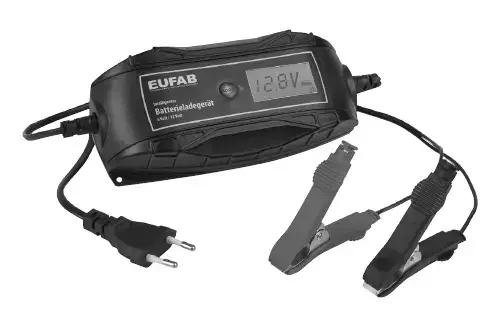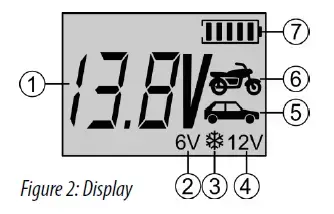EUFAB 16615 6/12 V 4 A Intelligent Battery Charger
WARNING: Read the operating instructions through carefully prior to initial use and observe all of the safety notes! Not observing such may lead to personal injury, damages to the device or your property! Store the original packaging, the receipt and these instructions so that they may be consulted at a later date! Priortoinitial use check the contents of the packaging to ensure that they are in perfect condition and complete! Intelligent battery charger 6/12 V 4 A
INTENDED USE
The charger is suitable for charging open and a variety of closed, maintenance-free lead-acid batteries, for example:
- Wet batteries (WET), lead-acid batteries (fluid electrolyte)
- Gel batteries (gel electrolyte)
- AGM batteries (electrolyte in fiberglass fleece)
- Maintenance-free lead-acid batteries (MF) Other batteries may not be charged with this device.
Other batteries may not be charged with this device. The charger may not be used as a starter aid. First charge the battery of your vehicle fully and remove the charger before starting the vehicle. The charger may not be used as a source of direct current or for other purposes. The battery charger is designed for use in dry and protected environments at temperatures of -5 °C to +40°C. his device is not designed to be used by children and people with limited mental capacities or those without experience and/or knowledge. Keep children away from the device. The device is not designated for commercial use. Any other use or modification to the device is considered improper usage and may be dangerous. EAL GmbH accepts no liability for damages caused as a result of improper use.
SCOPE OF DELIVERY
- Charger
- Operating instructions
SPECIFICATIONS
- Dimensions: approx. 180 x 80 x 45 mm
- Weight: approx. 0.465 kg
- Long mains cable: approx. 1.50 m
- Long charger cable: approx. 1.50 m
- Input: 220-240 V AC, 50/60 Hz
- Output: 6 V mode: 6 V DC, 2.0 A
- Motorbike: 12 V DC, 2.0 A
- Car: 12 V DC, 4.0 A
- Battery capacity: 6 V min 1.2 Ah, max. 14 Ah
- 12 V min 1.2 Ah, max. 120 Ah
Protection class: IP65 (only device housing, not connection and charging cable) Ambient temperature: -5 °C to +40 °C
EXPLANATION OF SYMBOLS
- Corresponds to EC directive

- Labelled electrical product may not be disposed of in the household waste.

- Devices with this symbol may only be operated in the house (dry environment)

- Insulated housing (protection class II).

- Fuse, here: Slow-burning, 1.6 A

- Recommended battery capacity

- Protection class Spray water protected

- Read the operating instructions

SAFETY NOTES
- The warning triangle labels all instructions important to safety. Always follow these otherwise you could injure yourself or damage the device.
- Children must not play with the appliance.
- Cleaning and user-maintenance must not be carried out by children unless they are supervised.
- Only connect the device to a correctly installed socket. The voltage must correspond to the specification on the type plate of the device.
- Do not trap the power cable and protect it from sharp edges, damp, heat or oil. The power cable of the unit cannot be replaced. In the event that the cable is damaged, the unit must be disposed of.
- Do not operate the device or immediately pull the plug if it is damaged or you suspect it may be defective. In this case, contact our technicians.
- Pull the plug when the device is not in use.
- Keep packaging materials, especially plastic and plastic bags, away from children. Risk of suffocation!
- Remove all plastic from the device before use.
- Lay the mains cable in such a way that you are not hindered by it, and no one is able to accidentally pull it.
- Disconnect the battery charger from the power supply after charging.
- Keep the charger in a place that cannot be accessed by children or unauthorized persons.
- Never operate the device in the vicinity of flammable materials or in an environment prone to explosion.
- Always wear suitable working clothes, protective gloves and goggles. Battery acid is corrosive! Immediately and thoroughly wash off any splashed acid and consult a doctor if necessary. If battery acid gets into the eyes,
- immediately rinse under running water for at least 10 minutes and consult a doctor.
- Do not cover the charger, this may lead to overheating and result in damages. Never set the charger up for operation on a surface that is insulating (e.g. polystyrene). There is a risk of heat build up!
- If you wish to charge a vehicle battery in the installed state, first park the vehicle safely, put on the parking brake and switch off the ignition. Cut the battery (positive terminal) off from the on-board network of your vehicle To do this, consult the manual for your vehicle, or ask your specialist workshop.
- Disconnect the battery from your vehicle‘s electrical system. Refer to the manual of your vehicle or ask your specialist workshop.
- For vehicles with a start/stop system, please observe the specifications in the vehicle manual regarding charging the battery and the connection points. In the event of further questions, contact the manufacturer of your vehicle.
- When pulling the mains cable out of the socket, only hold the plug.
- Never expose the charger to the vicinity of fi re, heat and extensive temperatures over +40°C.
- Do not leave the charger connected for more than 5 days.
- Store these instructions carefully and, if necessary, pass them on to other users.
OPERATING INSTRUCTIONS
- A MODE button
- B Display
- C Charging cable
- D Pole callipers, red (+)
- E Pole callipers, black (-)
- F Mains cable

- Battery voltage display
- 6 V charging programme
- Winter charging programme
- 12 V charging programme
- Car charging programme
- Motorbike charging programme
- Battery charge status display

PREPARATION
Clean the battery pole of dust and corrosion residue. Only for open batteries: Top up with distilled water until the minimum filling level is reached. Leave the cells of the battery open until the end of the charging process. With maintenance-free batteries, follow the instructions of the battery manufacturer precisely.
CONNECTING THE BATTERY CHARGER
At the beginning of the charging process, if necessary, e.g. in the case of sulphated batteries, an attempt is made to regenerate the connected battery with the help of short pulsating current surges. This revitalization function is automatic and cannot be set directly. Depending on the charging state of the battery, the device adapts
the charging current in order to best charge the connected battery. The specified maximum charging current is only used during the main charging phase. Shortly before the full charging capacity is achieved, the device switches to a lower charging current. This ensures that the battery is gently and optimally charged to full capacity. The battery symbol (7) (Figure 2: Display) shown on the display indicates the current filling level of the battery. Make sure that the charger is not connected to the power socket. Always first connect the red plus cable (+) of the charger to the plus pole of the battery. Then connect the black minus cable (-) to the minus pole of the battery. If you wish to charge the battery while it is installed, connect the black minus cable (-) to the chassis, far away from the battery,
carburetor and fuel lines. Always stick to this sequence.
CAUTION
After plugging the mains cable unselect the desired charging pro- gramme by operating the MODE button multiple times. If the MODE
CAUTION
The charging programmes appear in the following order and may be selected by pressing the MODE button:
- Motorbike 6 V Motorbike 6 V winter
- Motorbike 12 V Motorbike 12 V winter
- Car 12 V Car 12 V winter
button is not pressed, the charging process is not started. When charging has started it is no longer possible to switch to another charging
program, If you wish to work with a program other than the set charging program, pull the plug out of the socket and wait until the display has gone dark. Then insert the plug again and proceed as described above. Now, connect the power plug of the charger to the mains socket. The background illumination
of the display is activated. If the battery has been connected incorrectly (wrong poles) or the charger has no contact, the following error message appears on the display ˝ Err 1˝. If the error message ˝Err 2˝is shown, a defective 6 V battery has been connected, this cannot be charged using the battery charger. If the battery has been correctly connected, the display shows the current battery voltage and the symbol for the set charging programme. By pressing (multiple times) the MODE button, you can select the appropriate charging programme for your needs. Disconnect the battery from your vehicle‘s electrical system. Refer to the manual of your vehicle or ask your specialist workshop. If you charge the battery while it is installed, there is a risk of damaging the vehicle electronics or the battery charger. battery
charger could be damaged.
POSSIBLE CHARGING PROGRAMMES
| 6 Volt mode
Charging programme for 6 V batteries, 1.2 Ah to 14 Ah, temperatures above 0°C Charge current: 2 A maximum charge voltage: 7.2 V |
 |
| 6 Volt winter mode
Charging programme for 6 V batteries, 1.2 Ah to 14 Ah, temperature below 0°C Charge current: 2 A maximum charge voltage: 7.4 V |
 |
| Motorbike mode
Charging programme for 12 V batteries from 1.2 Ah to 14 Ah, temperatures above 0°C Charge current: 2 A maximum charge voltage: 14.3 V |
 |
| Motorbike winter mode
Charging programme for 12 V batteries from 1.2 Ah to 14 Ah, temperatures below 0°C Charge current: 2 A maximum charge voltage: 14.8 V |
 |
| Car mode
Charging programme for 12 V batteries from 14 Ah to 120 Ah, temperatures above 0°C Charge current: 4 A maximum charge voltage: 14.6 V |
 |
| Car winter mode
Charging programme for 12V batteries from 14 Ah to 120 Ah, temperatures below 0°C Charge current: 4 A maximum charge voltage: 14.8 V |
 |
| Battery maintenance charge mode
This function is automatic and cannot be set directly. As soon as the battery is fully charged, the battery charger automatically switches to battery trickle charge mode. This is shown accordingly in the display (Only when removed). Never leave the charger connected for more than 5 days. |
 |
ERROR
| Display of error after faulty connection (wrong poles), short-circuit, connecting a deeply discharged battery, selection of an incorrect charging programme or overheating. |  |
| Error message in 6 V – mode, if a battery is connected with less than 5.5 V ± 0.2 or the voltage is still lower than 6 V after 4 hours of charging time.
Can also be displayed for 12 V batteries. The charger recognizes the deeply discharged 12 V battery as a 6 V |
 |
REMOVING THE CHARGER
The packaging is made up of environmentally friendly materials which may be disposed of via your local recycling points. Do not put electrical devices into the household waste. Electronic and electrical devices must be collected separately and sent for environmentally friendly recycling. Contact your community or town administration for information regarding the disposal of electrics.
NOTES REGARDING ENVIRONMENTAL PROTECTION
First pull the plug out of the socket and observe the sequence for disconnection. This prevents sparks from forming. Since charging generates a detonating gas, this is particularly important for the sake of your safety. Disconnect the charger from the mains power supply. Then disconnect the black callipers (minus). Then remove the battery callipers from the plus pole of the battery (red callipers). Allow the battery to cool and fill the cells with distilled water to the filling level named by the battery manufacturer. Close the battery cells using the caps.
MAINTENANCE AND CARE
If used correctly, the device is maintenance-free.
CARE
Clean the pole callipers every time the charging procedure is completed. Remove all splashed battery acid from the pole callipers to prevent corrosion. Clean the device carefully with a dry cloth. Do not use liquids or chemical cleaning agents. Never submerge the device in liquids. Never allow liquid to flow over the device. Before storing the device, roll up the cables properly using the designated hook in order to prevent damages to the cables and device. Store the device in a clean and
dry place.
CONTACT INFORMATION
EAL GmbH
Otto-Hausmann-Ring 107
42115 Wuppertal, Germany
+49 (0)202 42 92 83 0
+49 (0) 202 42 92 83 – 160
[email protected]
www.eal-vertrieb.com
